Abstract
A molecular phylogeny for the hominoid primates was constructed by using genetic distances from a survey of 383 radiolabeled fibroblast polypeptides resolved by two-dimensional electrophoresis (2DE). An internally consistent matrix of Nei genetic distances was generated on the basis of variants in electrophoretic position. The derived phylogenetic tree indicated a branching sequence, from oldest to most recent, of cercopithecoids (Macaca fascicularis), gibbon-siamang, orangutan, gorilla, and human-chimpanzee. A cladistic analysis of 240 electrophoretic characters that varied between ape species produced an identical tree. Genetic distance measures obtained by 2DE are largely consistent with those generated by other molecular procedures. In addition, the 2DE data set appears to resolve the human-chimpanzee-gorilla trichotomy in favor of a more recent association of chimpanzees and humans.
Full text
PDF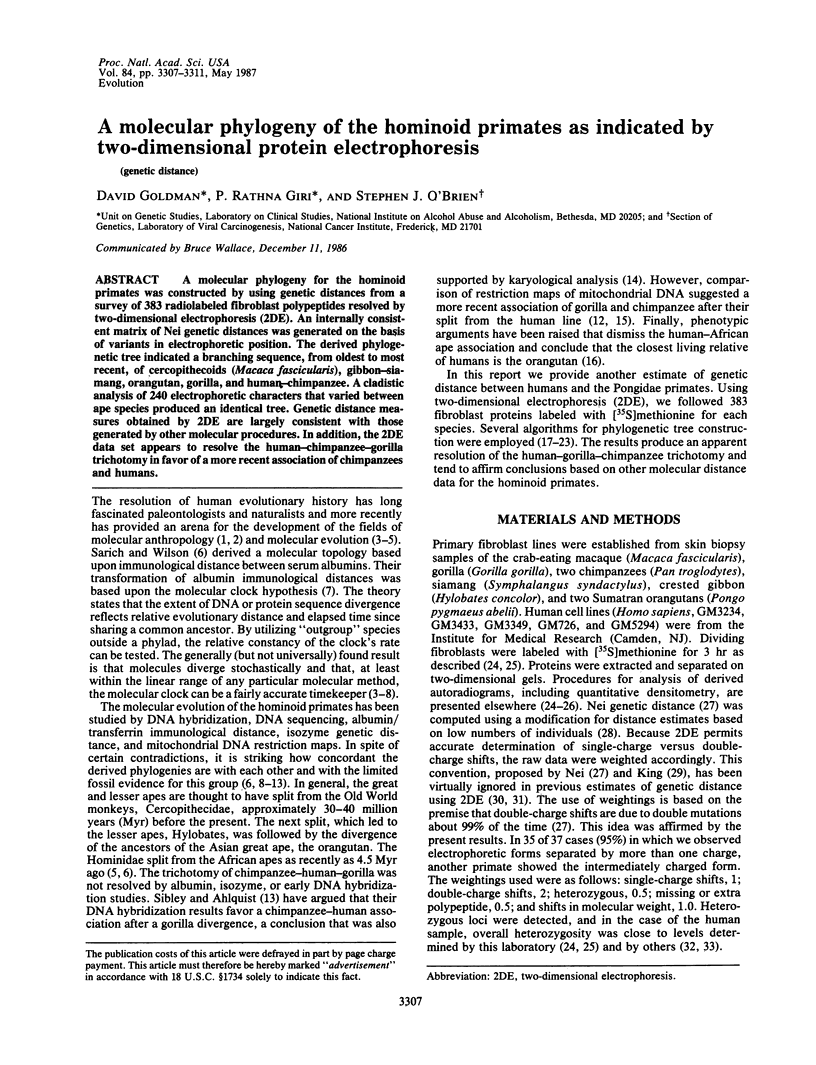
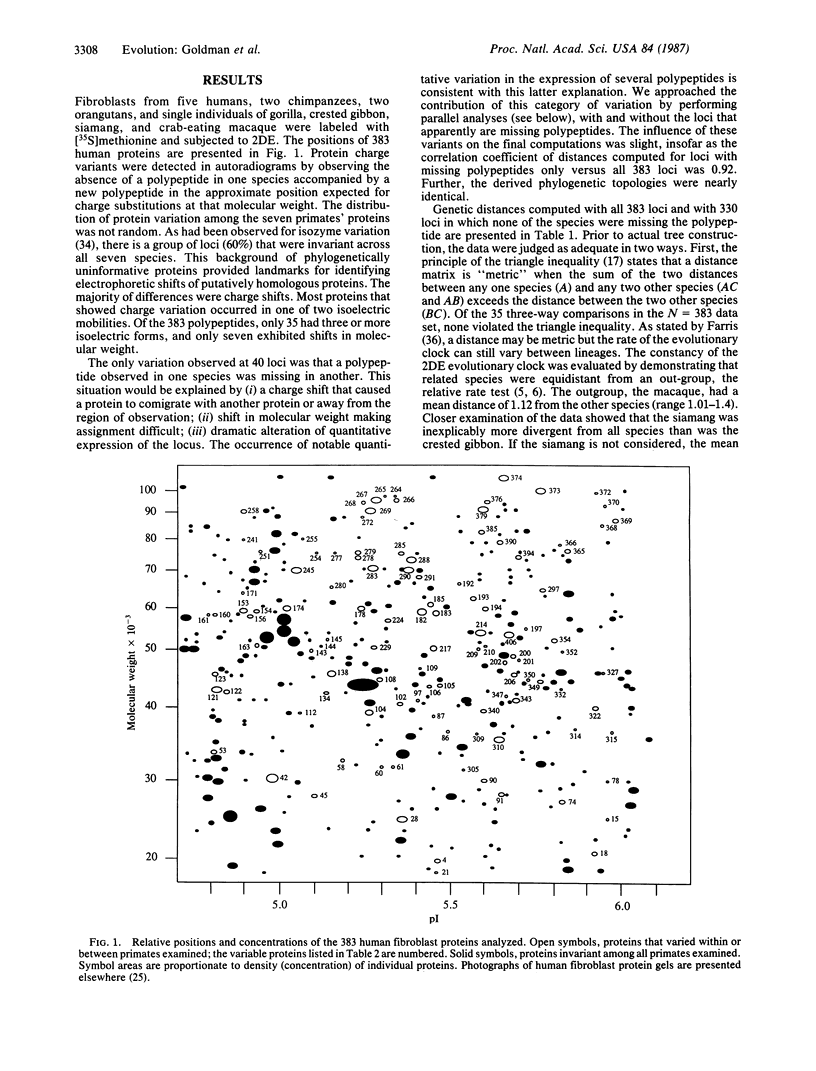
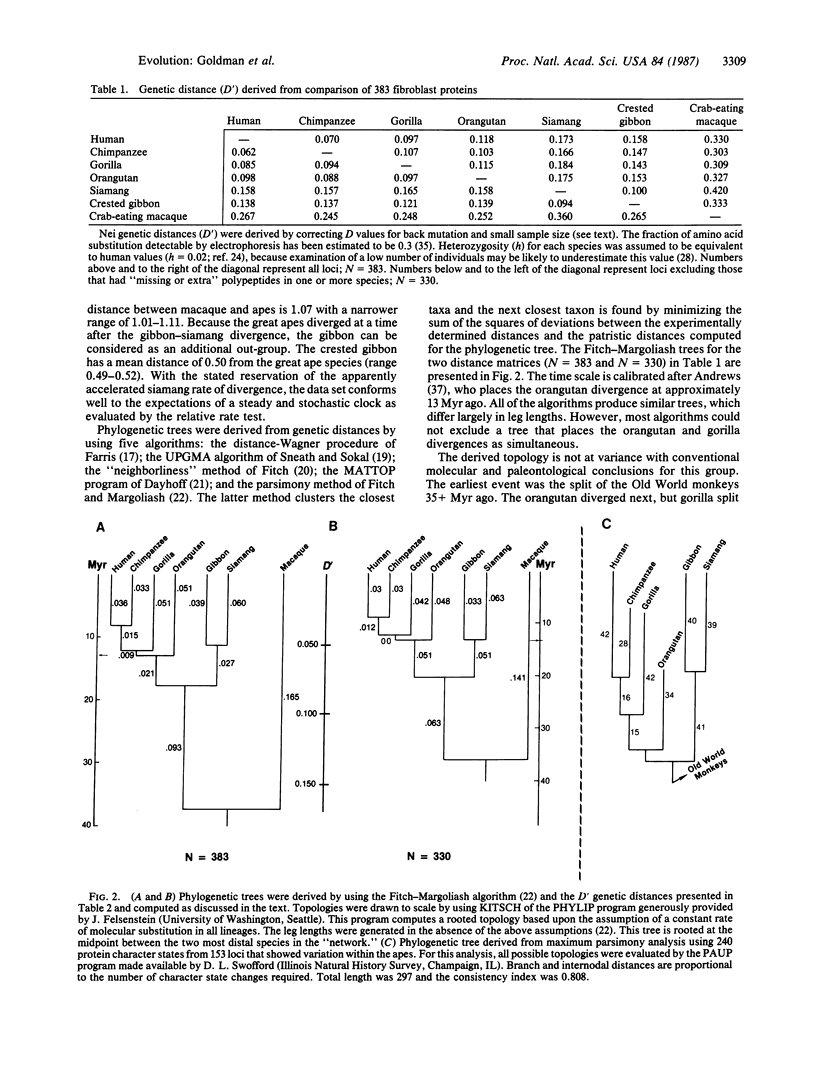
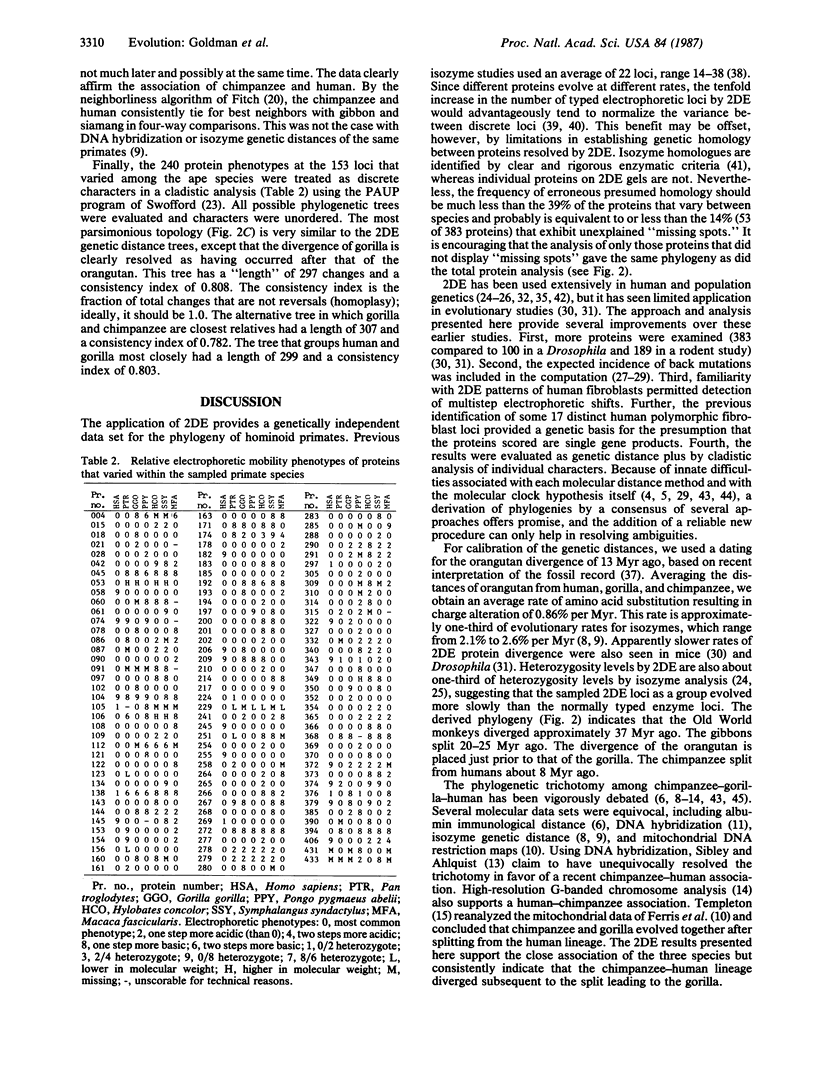
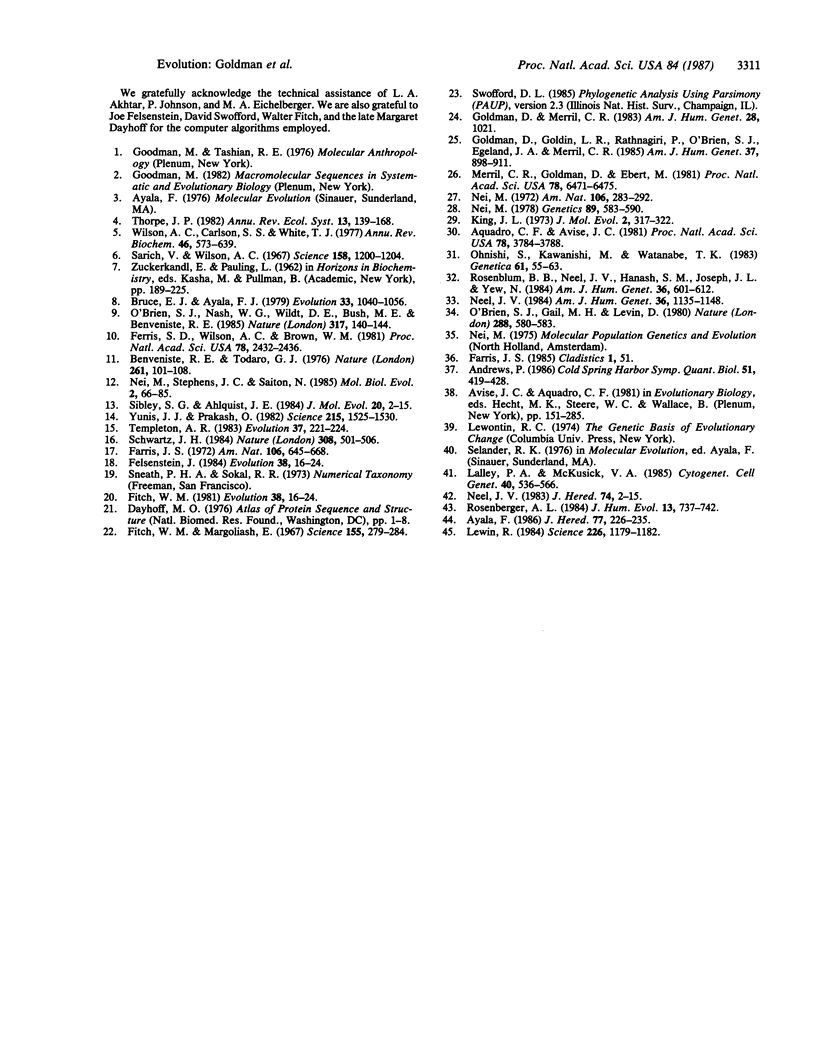
Selected References
These references are in PubMed. This may not be the complete list of references from this article.
- Andrews P. Fossil evidence on human origins and dispersal. Cold Spring Harb Symp Quant Biol. 1986;51(Pt 1):419–428. doi: 10.1101/sqb.1986.051.01.050. [DOI] [PubMed] [Google Scholar]
- Aquadro C. F., Avise J. C. Genetic divergence between rodent species assessed by using two-dimensional electrophoresis. Proc Natl Acad Sci U S A. 1981 Jun;78(6):3784–3788. doi: 10.1073/pnas.78.6.3784. [DOI] [PMC free article] [PubMed] [Google Scholar]
- Ayala F. J. On the virtues and pitfalls of the molecular evolutionary clock. J Hered. 1986 Jul-Aug;77(4):226–235. doi: 10.1093/oxfordjournals.jhered.a110227. [DOI] [PubMed] [Google Scholar]
- Benveniste R. E., Todaro G. J. Evolution of type C viral genes: evidence for an Asian origin of man. Nature. 1976 May 13;261(5556):101–108. doi: 10.1038/261101a0. [DOI] [PubMed] [Google Scholar]
- Ferris S. D., Wilson A. C., Brown W. M. Evolutionary tree for apes and humans based on cleavage maps of mitochondrial DNA. Proc Natl Acad Sci U S A. 1981 Apr;78(4):2432–2436. doi: 10.1073/pnas.78.4.2432. [DOI] [PMC free article] [PubMed] [Google Scholar]
- Fitch W. M., Margoliash E. Construction of phylogenetic trees. Science. 1967 Jan 20;155(3760):279–284. doi: 10.1126/science.155.3760.279. [DOI] [PubMed] [Google Scholar]
- Goldman D., Goldin L. R., Rathnagiri P., O'Brien S. J., Egeland J. A., Merril C. R. Twenty-seven protein polymorphisms by two-dimensional electrophoresis of serum, erythrocytes, and fibroblasts in two pedigrees. Am J Hum Genet. 1985 Sep;37(5):898–911. [PMC free article] [PubMed] [Google Scholar]
- Goldman D., Merril C. R., Polinsky R. J., Ebert M. H. Lymphocyte proteins in Huntington's disease: quantitative analysis by use of two-dimensional electrophoresis and computerized densitometry. Clin Chem. 1982 Apr;28(4 Pt 2):1021–1025. [PubMed] [Google Scholar]
- King J. L. The probability of electrophoretic idendity of proteins as a function of amino acid divergence. J Mol Evol. 1973 Nov 27;2(4):317–322. doi: 10.1007/BF01654099. [DOI] [PubMed] [Google Scholar]
- Lalley P. A., McKusick V. A. Report of the Committee on Comparative Mapping. Cytogenet Cell Genet. 1985;40(1-4):536–566. doi: 10.1159/000132187. [DOI] [PubMed] [Google Scholar]
- Lewin R. DNA reveals surprises in human family tree. Science. 1984 Dec 7;226(4679):1179–1182. doi: 10.1126/science.6505685. [DOI] [PubMed] [Google Scholar]
- Merril C. R., Goldman D., Ebert M. Protein variations associated with Lesch-Nyhan syndrome. Proc Natl Acad Sci U S A. 1981 Oct;78(10):6471–6475. doi: 10.1073/pnas.78.10.6471. [DOI] [PMC free article] [PubMed] [Google Scholar]
- Neel J. V. A revised estimate of the amount of genetic variation in human proteins: implications for the distribution of DNA polymorphisms. Am J Hum Genet. 1984 Sep;36(5):1135–1148. [PMC free article] [PubMed] [Google Scholar]
- Neel J. V. Frequency of spontaneous and induced "point" mutations in higher eukaryotes. J Hered. 1983 Jan-Feb;74(1):2–15. doi: 10.1093/oxfordjournals.jhered.a109711. [DOI] [PubMed] [Google Scholar]
- Nei M. Estimation of average heterozygosity and genetic distance from a small number of individuals. Genetics. 1978 Jul;89(3):583–590. doi: 10.1093/genetics/89.3.583. [DOI] [PMC free article] [PubMed] [Google Scholar]
- Nei M., Stephens J. C., Saitou N. Methods for computing the standard errors of branching points in an evolutionary tree and their application to molecular data from humans and apes. Mol Biol Evol. 1985 Jan;2(1):66–85. doi: 10.1093/oxfordjournals.molbev.a040333. [DOI] [PubMed] [Google Scholar]
- O'Brien S. J., Gail M. H., Levin D. L. Correlative genetic variation in natural populations of cats, mice and men. Nature. 1980 Dec 11;288(5791):580–583. doi: 10.1038/288580a0. [DOI] [PubMed] [Google Scholar]
- O'Brien S. J., Nash W. G., Wildt D. E., Bush M. E., Benveniste R. E. A molecular solution to the riddle of the giant panda's phylogeny. Nature. 1985 Sep 12;317(6033):140–144. doi: 10.1038/317140a0. [DOI] [PubMed] [Google Scholar]
- Rosenblum B. B., Neel J. V., Hanash S. M., Joseph J. L., Yew N. Identification of genetic variants in erythrocyte lysate by two-dimensional gel electrophoresis. Am J Hum Genet. 1984 May;36(3):601–612. [PMC free article] [PubMed] [Google Scholar]
- Sarich V. M., Wilson A. C. Immunological time scale for hominid evolution. Science. 1967 Dec 1;158(3805):1200–1203. doi: 10.1126/science.158.3805.1200. [DOI] [PubMed] [Google Scholar]
- Schwartz J. H. The evolutionary relationships of man and orang-utans. Nature. 1984 Apr 5;308(5959):501–505. doi: 10.1038/308501a0. [DOI] [PubMed] [Google Scholar]
- Sibley C. G., Ahlquist J. E. The phylogeny of the hominoid primates, as indicated by DNA-DNA hybridization. J Mol Evol. 1984;20(1):2–15. doi: 10.1007/BF02101980. [DOI] [PubMed] [Google Scholar]
- Wilson A. C., Carlson S. S., White T. J. Biochemical evolution. Annu Rev Biochem. 1977;46:573–639. doi: 10.1146/annurev.bi.46.070177.003041. [DOI] [PubMed] [Google Scholar]
- Yunis J. J., Prakash O. The origin of man: a chromosomal pictorial legacy. Science. 1982 Mar 19;215(4539):1525–1530. doi: 10.1126/science.7063861. [DOI] [PubMed] [Google Scholar]


